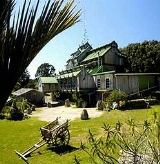
Tapu Te Ranga Marae
Encyclopedia
Tapu Te Ranga Marae is a "living" marae
in Island Bay, Wellington
, New Zealand
. It is the home of author Bruce Stewart
, his family and various friends. The Marae is listed as a heritage site.
Stewart bought the whenua (land) to set it free from private ownership. Tikanga (principles) of kaitiaki
(caretaker protector nurturer) govern the marae. Starting in 1974, Bruce worked alongside unemployed Maori youth, some were "sleeping out", all without skills. They salvaged native timbers usually ‘balled’ and ‘crunched’, restored and shaped by their hands.
For over three decades they persevered. It is back from the brink of extinction. Now it is a strong social, artistic, cultural and environmental statement. Living Maori in today’s world. “We could not have done it without the support of many good people in the community special mention of Sir Michael Fowler
.” says Bruce.
Testament of Maori youth, making the impossible come true, their turangawaewae
(standing place); without it they have no place to stand. They did what all poor people do; use everyone’s rubbish. The world's largest and tallest fully wooden house built of recycled materials—fully wooden is of wooden structure on wooden piles. There are ten levels, 27000 square feet (2,508.4 m²), 131 feet (39.9 m) high. Thousands visit the marae from all corners of the earth.
The marae is set in 50 acres (202,343 m²). Most of it has been planted with native trees sourced from remnants of the original forest; 100,000 trees have been planted. Native birds are slowly returning. Manawa Karioi, good people from the local community, manage the reforestation. “It’s our church…sitting there breathing deeply the fragrances of a vigorous teen-aged forest…listening to the many sounds of silence…more and more native birds appear…sometimes they sing…it all flutters the heart,” says Bruce.
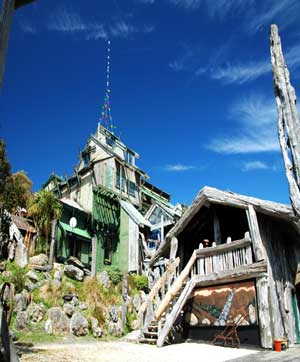
 The main tupuna whare
The main tupuna whare
(ancestral house) is Parehinetai o Waitaha. The whare rambles up the hill on many levels, a strong social, environmental and artistic statement. She was built out of need by young unemployed Maori.
is the whakatauki (proverb).
Marae
A marae malae , malae , is a communal or sacred place which serves religious and social purposes in Polynesian societies...
in Island Bay, Wellington
Wellington
Wellington is the capital city and third most populous urban area of New Zealand, although it is likely to have surpassed Christchurch due to the exodus following the Canterbury Earthquake. It is at the southwestern tip of the North Island, between Cook Strait and the Rimutaka Range...
, New Zealand
New Zealand
New Zealand is an island country in the south-western Pacific Ocean comprising two main landmasses and numerous smaller islands. The country is situated some east of Australia across the Tasman Sea, and roughly south of the Pacific island nations of New Caledonia, Fiji, and Tonga...
. It is the home of author Bruce Stewart
Bruce Stewart
Bruce Stewart is a New Zealand-born fiction writer and dramatist of Ngāti Raukawa Te Arawa descent. Stewart's work is marked by expressions of the anger, confused loyalties and spiritual aspiration of late-twentieth-century Māori...
, his family and various friends. The Marae is listed as a heritage site.
Stewart bought the whenua (land) to set it free from private ownership. Tikanga (principles) of kaitiaki
Kaitiaki
Kaitiaki is a New Zealand term used for the Māori concept of guardianship, for the sky, the sea, and the land. A kaitiaki is a guardian, and the process and practices of protecting and looking after the environment are referred to as kaitiakitanga and include rāhui and tapuThe term kaitiaki is also...
(caretaker protector nurturer) govern the marae. Starting in 1974, Bruce worked alongside unemployed Maori youth, some were "sleeping out", all without skills. They salvaged native timbers usually ‘balled’ and ‘crunched’, restored and shaped by their hands.
For over three decades they persevered. It is back from the brink of extinction. Now it is a strong social, artistic, cultural and environmental statement. Living Maori in today’s world. “We could not have done it without the support of many good people in the community special mention of Sir Michael Fowler
Michael Fowler
Sir Edward "Michael" Coulson Fowler, FNZIA, , is a New Zealand architect and author who served as Mayor of Wellington from 1974 to 1983.-Biography:He was born in 1929 in Marton, and was educated at Christ's College in Christchurch....
.” says Bruce.
Testament of Maori youth, making the impossible come true, their turangawaewae
Turangawaewae
Turangawaewae Marae is a very significant marae of the Māori people of New Zealand and is the headquarters for the Māori King Movement...
(standing place); without it they have no place to stand. They did what all poor people do; use everyone’s rubbish. The world's largest and tallest fully wooden house built of recycled materials—fully wooden is of wooden structure on wooden piles. There are ten levels, 27000 square feet (2,508.4 m²), 131 feet (39.9 m) high. Thousands visit the marae from all corners of the earth.
The marae is set in 50 acres (202,343 m²). Most of it has been planted with native trees sourced from remnants of the original forest; 100,000 trees have been planted. Native birds are slowly returning. Manawa Karioi, good people from the local community, manage the reforestation. “It’s our church…sitting there breathing deeply the fragrances of a vigorous teen-aged forest…listening to the many sounds of silence…more and more native birds appear…sometimes they sing…it all flutters the heart,” says Bruce.
Buildings


Wharenui
A wharenui is a communal house of the Māori people of New Zealand, generally situated as the focal point of a marae. Wharenui are usually called 'meeting houses' in New Zealand English.-Wharenui:...
(ancestral house) is Parehinetai o Waitaha. The whare rambles up the hill on many levels, a strong social, environmental and artistic statement. She was built out of need by young unemployed Maori.
- "They who build the whare, are built by the whare"
is the whakatauki (proverb).
Art
Excerpt from Robyn Kahukiwa's book The Art of Robyn Kahukiwa:- "In 1998 Bruce Stewart, rangatira of Tapu Te Ranga marae in Island Bay, Wellington asked me for artwork for the new Whare Wahine, Ukaipo. Te Waka Toi, the Maori arm of Creative New ZealandCreative New ZealandThe Arts Council of New Zealand Toi Aotearoa is the national arts development agency of the New Zealand government, investing in artists and arts organisations, offering capability building programmes and developing markets and audiences for New Zealand arts domestically and internationally...
, gave me a generous grant to enable me to undertake this work, For me, a woman artist of Maori descent, this was a once-in-a-lifetime opportunity. To be involved with the making of artworks for a whare was an honour and a privilege. It was doubly significant for the degree of involvement in creation of a house that is limited to men in many iwi. It took about 18 months to create the pou and to complete the painting."
Gallery
 |
 |
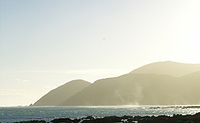 |
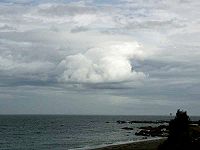 |
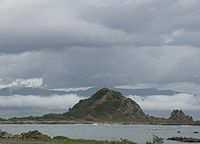 |
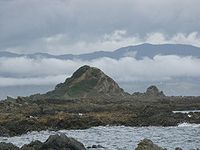 |
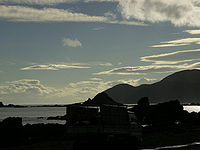 |
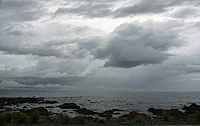 |
See also
- Bruce StewartBruce StewartBruce Stewart is a New Zealand-born fiction writer and dramatist of Ngāti Raukawa Te Arawa descent. Stewart's work is marked by expressions of the anger, confused loyalties and spiritual aspiration of late-twentieth-century Māori...
- Island Bay
- Te Raekaihau PointTe Raekaihau PointTe Raekaihau Point is a rugged coastal landform in Wellington, New Zealand, adjacent to Princess Bay, between Houghton Bay to the west and Lyall Bay to the east on the south coast. One meaning of the name is "the headland that eats the wind"...
- Robyn Kahukiwa
- KaitiakiKaitiakiKaitiaki is a New Zealand term used for the Māori concept of guardianship, for the sky, the sea, and the land. A kaitiaki is a guardian, and the process and practices of protecting and looking after the environment are referred to as kaitiakitanga and include rāhui and tapuThe term kaitiaki is also...

